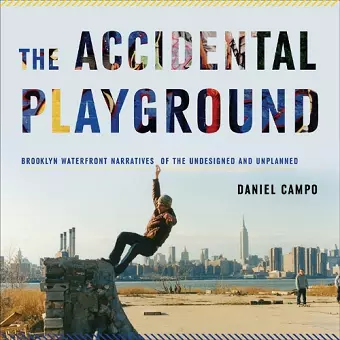The Accidental Playground
Brooklyn Waterfront Narratives of the Undesigned and Unplanned
Format:Paperback
Publisher:Fordham University Press
Published:10th Sep '13
Currently unavailable, and unfortunately no date known when it will be back

Highly illustrated and artfully researched, the book will draw readers into a unique space in one of New York City's most popular boroughs.
The Accidental Playground explores the remarkable landscape created by individuals and small groups who occupied and rebuilt an abandoned Brooklyn waterfront. While local residents, activists, garbage haulers, real estate developers, speculators, and two city administrations fought over the fate of the former Brooklyn Eastern District Terminal (BEDT), others simply took to this decaying edge, transforming it into a unique venue for leisure, creative, and everyday practices. These occupiers and do-it-yourself builders created their own waterfront parks and civic spaces absent every resource needed for successful urban development, including plans, designs, capital, professional assistance, consensus, and permission from the waterfront’s owners. Amid trash, ruins, weeds, homeless encampments, and the operation of an active garbage transfer station, they inadvertently created the “Brooklyn Riviera” and made this waterfront a destination that offered much more than its panoramic vistas of the Manhattan skyline. The terminal evolved into the home turf for unusual and sometimes spectacular recreational, social, and creative subcultures, including the skateboarders who built a short-lived but nationally renowned skatepark, a twenty-five-piece “public” marching band, fire performance troupes, artists, photographers, and filmmakers. At the same time it served the basic recreational needs of local residents. Collapsing piers became great places to catch fish, sunbathe, or take in the views; the foundation of a demolished warehouse became an ideal place to picnic, practice music, or do an art project; rubble-strewn earth became a compelling setting for film and fashion shoots; a broken bulkhead became a beach; and thick patches of weeds dotted by ailanthus trees became a jungle. These reclamations, all but ignored by city and state governments and property interests that were set to transform this waterfront, momentarily added to the distinctive cultural landscape of the city’s most bohemian and rapidly changing neighborhood.
Drawing on a rich mix of documentary strategies, including observation, ethnography, photography, and first-person narrative, Daniel Campo probes this accidental playground, allowing those who created it to share and examine their own narratives, perspectives, and conflicts. The multiple constituencies of this waterfront were surprisingly diverse, their stories colorful and provocative. When taken together, Campo argues, they suggest a radical reimagining of urban parks and public spaces, and the practices by which they are created and maintained.
The Accidental Playground, which treats readers...
"The Accidental Playground provides an informative and fascinating study of a unique area of Brooklyn. From skateboarding and marching bands to artworks and impromptu residences, Campo's perceptive eye and insightful interpretations provide a convincing account of the diverse value of city wastelands for creative urban living." -- -Iain Borden Bartlett School of Architecture, UCL "Campo's close, yet open, reading should be an inspiration for students of planning and urbanism, and for contemporary practitioners..." -Journal of Design History "Daniel Campo's book, 'The Accidental Playground,' tells the story of an abandoned rail terminal on the North Brooklyn waterfront that between 200 and 2010 became the home turf of skateboarders, artists, marching bands, homeless people, and neighborhood residents in need of a bigger and freer backyard." -Next City "... we could all benefit from Campo's challenge to incorporate a broader view of par constituencies and develop a richer appreciation for the connections between place and the breadth of human experience." -Journal of Planning Education and Research "At some point in the late-1980s a free space opened up on the waterfront of North Brooklyn. It was an unlikely paradise yet the artists, musicians, fishermen, teenagers and homeless that gathered there all fell under its spell. You stood in full view of the metal towers of Manhattan but it was so quiet that you could hear the waves breaking on the shore and the low hum of traffic across the river on the FDR Drive. Of course it couldn't last. In this magisterial account of the waterfront, Daniel Campo expertly deploys chops from many disciplines - anthropology, urban studies, journalism, architecture - to paint a vivid portrait of a lost world. Over years of research, he won the trust of the locals and they told him what the waterfront meant to them. Campo is a scholar who can write, and his stories preserve the magic of an urban wilderness that has been obliterated by the scheming of the rich and powerful. The Accidental Playground is both timeless and cautionary: places like the Williamsburg waterfront are essential, but if we don't listen to visionaries like Campo, they'll always be stolen from us." -- -Robert Anasi The Last Bohemia: Scenes from the Life of Williamsburg, Brooklyn "Daniel Campo. a former New York City planner, considers the serendipitous development of Williamsburg ..." -Sam Roberts, The New York Times "The Accidental Playground provides a great contribution to emerging debates on vernacular creative city dynamics. In particular it offers a critical view on urban politics in relation to the design and planning of parks and other public spaces." -societyandspace.com "Daniel Campo's The Accidental Playground explores critical terrain at the intersection of urban planning, insurgent space, and visual culture. Campo's deep and sensitive portrait of a unique city space eliminated by business-as-usual New York development politics is a thoughtful paen to do-it-yourself placemaking, but also a nuanced warning that planning-for-profit can leave the true public good behind." -- -Brent D. Ryan Associate Professor of Urban Design and Public Policy, MIT
ISBN: 9780823251865
Dimensions: unknown
Weight: unknown
304 pages